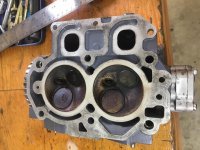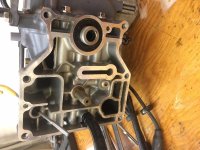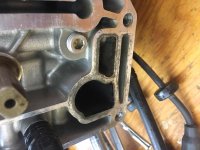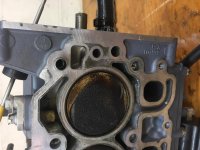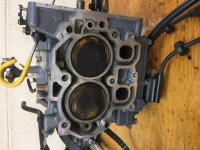So I was planning a fishing trip on the West Coast with my family. I did my annual maintenance this morning. Everything else went well except my kicker. The crankcase oil was full and looked new before I started it (8hours since it was overhauled). I warmed it up and dumped the oil. Unfortunately it was full of water (Milky) after warming it up.
What should I do from here?
For background :
2001 ish Mercury 15hp 4stroke bigfoot
this is a high hours (idling trolling kicker)
it is primarily a fresh water motor with 5-10 days salt/year.
it is well maintained and is in very good overall condition.
Last year an intake valve spring broke and a piston hit the valve.
Over the winter I replaced the damaged intake valve, all springs, all guides, all seals, the head gasket, and the powerhead gasket.
I had a reputable shop do the head work for me because It's beyond my capacity.
The re and re I did myself because that's within my skill set.
All surfaces were clean when re-assembled and the torques were exactly to the specs in the shop manual.
I have run it for about 8 hours in freshwater since I completed the work and it ran like a champ.
Where should I go from here?
I'm considering changing the oil and going on vacation but it's an expensive gamble.
I'm considering changing the oil and running it locally to see if it goes milky again?
I'm considering pulling the valve cover and checking head torques.
I'm considering re-torquing the powerhead bolts.
I'm considering cancelling the fishing trip but my family is set on going.
Is there anything simple to check before I start a pull the powerhead and head gaskets?
I doubt it will have any obvious signs of trouble with only 4 hours of run time.
Thanks for your advice
Jeff
What should I do from here?
For background :
2001 ish Mercury 15hp 4stroke bigfoot
this is a high hours (idling trolling kicker)
it is primarily a fresh water motor with 5-10 days salt/year.
it is well maintained and is in very good overall condition.
Last year an intake valve spring broke and a piston hit the valve.
Over the winter I replaced the damaged intake valve, all springs, all guides, all seals, the head gasket, and the powerhead gasket.
I had a reputable shop do the head work for me because It's beyond my capacity.
The re and re I did myself because that's within my skill set.
All surfaces were clean when re-assembled and the torques were exactly to the specs in the shop manual.
I have run it for about 8 hours in freshwater since I completed the work and it ran like a champ.
Where should I go from here?
I'm considering changing the oil and going on vacation but it's an expensive gamble.
I'm considering changing the oil and running it locally to see if it goes milky again?
I'm considering pulling the valve cover and checking head torques.
I'm considering re-torquing the powerhead bolts.
I'm considering cancelling the fishing trip but my family is set on going.
Is there anything simple to check before I start a pull the powerhead and head gaskets?
I doubt it will have any obvious signs of trouble with only 4 hours of run time.
Thanks for your advice
Jeff


